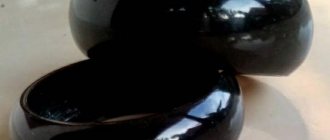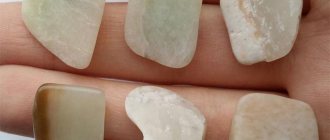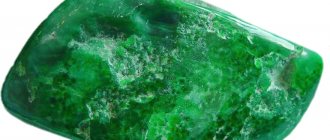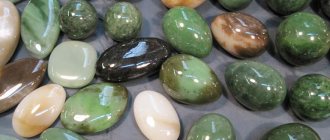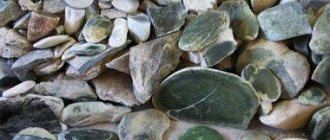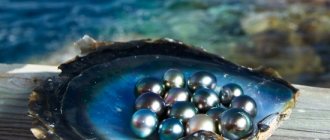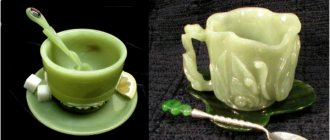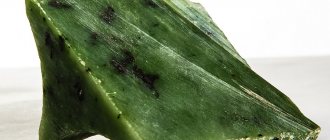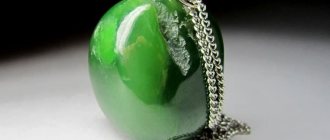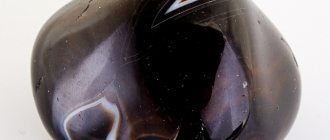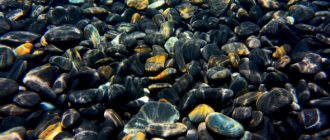Unremarkable in appearance, black jade has become a real legend. Its magical properties have been known since ancient times; it often became an attribute of various rituals and customs. This type of jade gained particular popularity and respect in Eastern countries.
What kind of mineral is this, what properties does it have , what is the secret of its popularity?
Origin and properties of black jade
No matter what mystical versions explain the origin of black jade, scientists have studied the mineral and convincingly proved its terrestrial nature.
The stone belongs to a monomineral rock and, according to its chemical formula, is calcium and magnesium silicate. Experts include it in the group of jads .
The color of the mineral varies from dark olive to completely black. Jade has high thermal conductivity: if it is heated, it will remain warm for a long time.
Where is black jade mined?
A blue-black mineral with a neat waxy or oily sheen is quite rare in nature. Its main deposits are located in Russia (Buryatia) and China (Shandong). Considering the high popularity of this stone among the inhabitants of the Middle Kingdom, most of the mined Russian stone is imported to China.
Black jade is most often found in places where magnetic ores occur. This gave rise to a version about the extraterrestrial origin of the stone. Some researchers believe that this mineral is nothing more than fragments of a meteorite that survived a collision with the earth more than 60 million years ago. As evidence, scientists point to a chemical composition containing iridium, which is an indicator of the meteorite origin of the rocks.
It is worth noting that the extraction of the dark variety of jade is carried out too intensively and, according to experts, the reserves of this stone in both Russia and China are already running out. This is the reason for the sharp increase in the cost of “black jade” in the Asian market of semi-precious minerals.
Myths and legends of black mineral
Having endowed the stone with mystical properties, our ancestors began to actively use it as talismans and other ritual attributes. This is how many myths about his mysterious power were born .
In Uzbekistan there is the legendary Gur-Emir mausoleum - the burial place of Tamerlane. The gravestone of the great commander and ruler is made of black jade slabs, which were brought from China by his grandson, Ulugbek.
It is still believed that if the slabs are moved from their place and Tamerlane’s ashes are disturbed, a lot of blood will be shed again. In the 20th century, this warning received real confirmation: on June 21, 1941, Soviet scientists opened the tomb of Tamerlane, and on June 22, the Great Patriotic War began.
Another beautiful legend says that the Indian leader Montezuma thanked heaven for the fact that the Spanish conquerors took gold, but did not know anything about the reserves of black jade.
The great Alexander the Great, when going into battle, always wore a pendant with a magical mineral. He believed that she brought him victories. One day, while relaxing on the banks of the Euphrates, he dropped his talisman into the dark waters of the river and could not find it. The loss sadly affected the fate of the famous commander: luck turned away from him.
In China, the seals of rulers were made of black jade : the mineral symbolized the approval of the gods for the rule of this person. The Chinese ambassadors presented Queen Victoria of England with a scepter made of jade as a gift. They say that the queen never parted with this symbol of power.
Jades of Altai
Altai jades were discovered in the 60s. XX century The deposits are small in size and are located in the following places:
- Charysh-Terektinsky deep fault (Terektinsky ridge) - from the village of Kaitanak to the Koir River (Akkemskoe, Baltyrganskoe, Aryskanskoe, Tomulskoe, Muinokhskoe manifestations, which are located mainly near streams);
- Kurai fault;
- Shalapsky fault;
- Akkem river (village Chagan-Uzun), Cheremshanka.
Altai minerals are of low quality: dirty green, fissured. According to some estimates, the total reserves of jade in Altai are about 200 tons.
Types of amulets and talismans
The popularity of the stone in the East is so great that in almost every home you can see figurines and other crafts made of black jade. Most talismans are made in the form of three significant figures :
- Bat. This amazing nocturnal animal is believed to bring good luck and fortune.
- The Phoenix bird is endowed with the ability to increase the owner’s material well-being. She attracts money into the house.
- The deer symbolizes honor and courage.
To enhance the magical abilities of the stone, products made from it are set in white metal (silver or platinum).
If you hang pieces of mineral over the entrance to the house, not a single dark entity will penetrate inside. The mineral worn on the body suppresses irritability and protects the owner from scandals.
Esotericists and astrologers use jade balls during meditation : the figures help them dive deeper into the astral world and discover an understanding of its laws.
The modern life of the mineral is a bianshi bracelet made of black jade, but we will talk about it later.
Important! Black jade constantly absorbs the negative energy of space. To ensure that the talisman always remains in working condition, it must be periodically washed under running water.
Extraction methods
Deposits where jade is mined in Russia are developed using 2 methods:
- Open pit mining using heavy equipment (bulldozers, excavators). In Buryatia, about 90% of all jades are obtained this way. Raw materials are transported along taiga roads, winter roads (roads that are used only in winter) or by helicopter.
- Collecting pellets (boulders and pebbles) at the bottom of rivers. This is the most dangerous method of extraction, but this type of raw material is highly valued - its price is tens of times higher than the price of a mineral mined in a quarry. This work requires scuba gear, compressors and highly qualified divers.
Physical properties of the stone
The studies carried out revealed the following physical properties of the mineral:
- hardness – 5.5–6.5 on the Mohs scale;
- density – 2.95–3.4 g/cm³;
- there is no cleavage;
- transparency ranges from partial to complete absence;
- conchoidal fracture;
- glass shine;
- black color.
Despite the low density, the mineral has a viscous structure, which provides it with a strength higher than steel and granite.
View this post on Instagram
Publication from Olga
